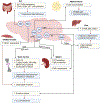Central regulation of stress-evoked peripheral immune responses
- PMID: 37626176
- PMCID: PMC10848316
- DOI: 10.1038/s41583-023-00729-2
Central regulation of stress-evoked peripheral immune responses
Abstract
Stress-linked psychiatric disorders, including anxiety and major depressive disorder, are associated with systemic inflammation. Recent studies have reported stress-induced alterations in haematopoiesis that result in monocytosis, neutrophilia, lymphocytopenia and, consequently, in the upregulation of pro-inflammatory processes in immunologically relevant peripheral tissues. There is now evidence that this peripheral inflammation contributes to the development of psychiatric symptoms as well as to common co-morbidities of psychiatric disorders such as metabolic syndrome and immunosuppression. Here, we review the specific brain and spinal regions, and the neuronal populations within them, that respond to stress and transmit signals to peripheral tissues via the autonomic nervous system or neuroendocrine pathways to influence immunological function. We comprehensively summarize studies that have employed retrograde tracing to define neurocircuits linking the brain to the bone marrow, spleen, gut, adipose tissue and liver. Moreover, we highlight studies that have used chemogenetic or optogenetic manipulation or intracerebroventricular administration of peptide hormones to control somatic immune responses. Collectively, this growing body of literature illustrates potential mechanisms through which stress signals are conveyed from the CNS to immune cells to regulate stress-relevant behaviours and comorbid pathophysiology.
© 2023. Springer Nature Limited.
Conflict of interest statement
Competing interests
The authors declare no competing interests
Figures



References
-
- O’Connor DB, Thayer JF & Vedhara K Stress and Health: A Review of Psychobiological Processes. Annu. Rev. Psychol 72, 663–688 (2021). - PubMed
Publication types
MeSH terms
Grants and funding
LinkOut - more resources
Full Text Sources

